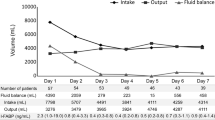Abstract
Objectives: (a) To investigate the relationship between gut ischemia parameters (gastric intramucosal pH [pHi], mucosal–arterial carbon dioxide difference [PCO2-gap]), and endotoxin or cytokine release during hemorrhagic shock; (b) to compare the predictive value of pHi, PCO2-gap and arterial lactate concentrations. Design: Prospective study. Setting: Surgical intensive care unit of a university hospital. Patients: 20 multiple trauma patients with severe hemorrhagic shock. Interventions: Intramucosal measurements and blood samples were obtained on admission to the emergency room and repeatedly over 48 h. Measurements and results: Endotoxin was measured using a chromogenic limulus amoebocyte assay. Cytokine [tumor necrosis factor-α (TNFα) and interleukin-6 (IL-6)] values were evaluated by immunoradiometric assays. Only 3 patients had positive blood cultures but endotoxins were detected at least once in all patients. Endotoxin levels were similar in survivors and nonsurvivors over the study period and were not related to pHi or PCO2-gap. Initially, high levels of IL-6 were observed in both nonsurvivors and survivors [median 1778 pg/ml (range 435–44 540) vs 2068 pg/ml (range 996–92 300)]. IL-6 levels progressively decreased in the survivors but not significantly. On admission, TNFα concentrations were similar in nonsurvivors and survivors (42 ± 35 vs 46 ± 27 pg/ml). From the 24th h, TNFα values were higher in the nonsurvivors than in the survivors (24 h: 72 ± 38 vs 34 ± 17 pg/ml, p < 0.05). The greatest IL-6 levels were found for a pHi < 7.20 (28.5 ± 36.5 vs 1.8 ± 1.3 ng/ml, p < 0.05) or a PCO2-gap > 7.5 mmHg (1 kPa) (32.5 ± 37.5 vs 1.7 ± 1.3 ng/ml, p < 0.01). With the same pHi threshold, no difference was found in endotoxin levels. The lactate concentrations were predictive for outcome from the 12th h (9.5 ± 5.9 vs 3.6 ± 2.3 mmol/l, p < 0.05). Conclusions: During severe hemorrhagic shock, endotoxin translocation from the gut was a common phenomenon that seemed independent of both pHi values and outcome. It could not explain IL-6 and TNFα release. In severe hemorrhagic shock, neither pHi nor PCO2-gap provides additional information to the lactate measurements.
Similar content being viewed by others
Author information
Authors and Affiliations
Additional information
Received: 17 February 1997 Accepted: 7 August 1997
Rights and permissions
About this article
Cite this article
Charpentier, C., Audibert, G., Dousset, B. et al. Is endotoxin and cytokine release related to a decrease in gastric intramucosal pH after hemorrhagic shock?. Intensive Care Med 23, 1040–1048 (1997). https://doi.org/10.1007/s001340050454
Issue Date:
DOI: https://doi.org/10.1007/s001340050454




